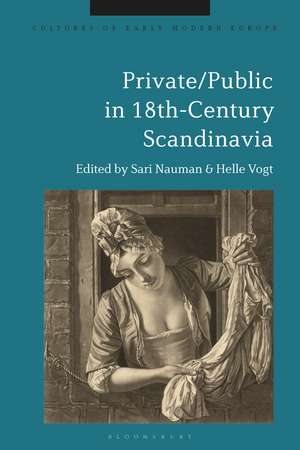Private/Public in 18th-Century Scandinavia: Cultures of Early Modern Europe
Editat de Dr Sari Nauman, Professor Helle Vogten Limba Engleză Paperback – 26 iul 2023
| Toate formatele și edițiile | Preț | Express |
|---|---|---|
| Paperback (1) | 192.19 lei 6-8 săpt. | |
| Bloomsbury Publishing – 26 iul 2023 | 192.19 lei 6-8 săpt. | |
| Hardback (1) | 540.38 lei 3-5 săpt. | |
| Bloomsbury Publishing – 26 ian 2022 | 540.38 lei 3-5 săpt. |
Preț: 192.19 lei
Preț vechi: 249.82 lei
-23% Nou
Puncte Express: 288
Preț estimativ în valută:
36.78€ • 38.26$ • 30.36£
36.78€ • 38.26$ • 30.36£
Carte tipărită la comandă
Livrare economică 15-29 aprilie
Preluare comenzi: 021 569.72.76
Specificații
ISBN-13: 9781350224933
ISBN-10: 1350224936
Pagini: 268
Ilustrații: 22 bw illus
Dimensiuni: 156 x 234 x 25 mm
Greutate: 0.38 kg
Editura: Bloomsbury Publishing
Colecția Bloomsbury Academic
Seria Cultures of Early Modern Europe
Locul publicării:London, United Kingdom
ISBN-10: 1350224936
Pagini: 268
Ilustrații: 22 bw illus
Dimensiuni: 156 x 234 x 25 mm
Greutate: 0.38 kg
Editura: Bloomsbury Publishing
Colecția Bloomsbury Academic
Seria Cultures of Early Modern Europe
Locul publicării:London, United Kingdom
Caracteristici
First book to explore the development of the idea of the private in relation to the public in early modern Scandinavia
Notă biografică
Sari Nauman is Postdoctoral Researcher at the University of Gothenburg, Sweden, and the University of Copenhagen, Denmark. She has published several articles, chapters and books, including the award-winning monograph Ordens kraft (2017).Helle Vogt is Professor of Legal History at the University of Copenhagen, Denmark. She is the author of The Function of Kinship in Medieval Nordic Legislation (2010) and the editor of Law and The Christian Tradition in Scandinavia (2020; with Kjell Å Modéer).
Cuprins
List of FiguresList of TablesList of ContributorsIntroduction. The Private in the Public: Scandinavia in the Eighteenth Century, Sari Nauman (University of Gothenburg, Sweden) and Helle Vogt (University of Copenhagen, Denmark)Part 1. Situating the private1. 'Only to the benefit of some private persons': The concept of 'private' in records from the Swedish estates assembly, 1521-1731, Charlotte Christensen-Nugues (Lund University, Sweden)2. Private as an economic concept: Natural law and economic agency, Pernille Ulla Knudsen (University of Copenhagen, Denmark)Part 2. Communication3 Talking in private - and keeping it private: Protecting conversations from exposure in Swedish Pietism investigations, 1723-1728, Johannes Ljungberg (University of Copenhagen, Denmark)4. Private news: Private letters as a source of news in eighteenth-century Copenhagen newspapers, Jørgen Mührmann-Lund (Western Norway University of Applied Sciences, Norway)5. Commercial newspaper and public shame pole: Exposure of individuals in the Copenhagen gazette Adresseavisen 1759-73, Jesper Jakobsen (University of Copenhagen, Denmark)6. Of chamber pots and scorned houses: Exposing hidden bodies and, private matters in eighteenth-century Copenhagen, Camilla Schjerning (Odense City Museums, Denmark)Part 3. Spaces7. Spaces for comfort, seclusion and privacy in a Swedish eighteenth-century town, Dag Lindström (Uppsala University, Sweden) and Göran Tagesson (National Historical Museums, Sweden)8. In death, nothing is private!: Public registration of the private home, Pernille Ulla Knudsen, (University of Copenhagen, Denmark)9. Public order and the experiment of implementing privacy in eighteenth-century Copenhagen, Ulrik Langen (University of Copenhagen, Denmark)10. Murder at the threshold: Private and public in an early modern peasant rebellion, Sari Nauman (University of Gothenburg, Sweden)Bibliography Index
Recenzii
The history of privacy and the private has emerged as a major topic of scholarly interest in the past decades. This collection adds important insights from a Scandinavian perspective. Exploring constellations of privacy in political, economic, religious, and quotidian contexts, the contributions to this volume deepen our understanding of the early modern period and especially the eighteenth century as a crucial period in the history of the private and the public.
A thought-provoking collection of essays that not only provides the reader with a rich variety of access points to the intertwined histories of private and public, but also does so from a Scandinavian perspective. In decentring our historical gaze from western Europe, these essays serve as a strong reminder that concepts as seemingly ubiquitous as private and public, need to be understood in their distinct geographic and cultural context.
A thought-provoking collection of essays that not only provides the reader with a rich variety of access points to the intertwined histories of private and public, but also does so from a Scandinavian perspective. In decentring our historical gaze from western Europe, these essays serve as a strong reminder that concepts as seemingly ubiquitous as private and public, need to be understood in their distinct geographic and cultural context.












